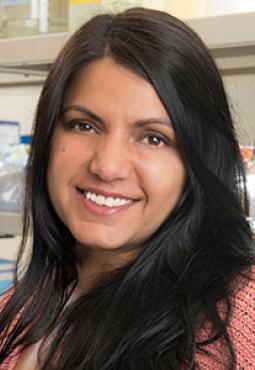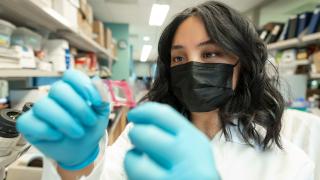
“City of Hope's presence at this year's ADA conference showcases our legacy and continued leadership in diabetes,” said Debbie C. Thurmond, Ph.D., director of the Arthur Riggs Diabetes & Metabolism Research Institute and Chan Soon-Shiong Shapiro Distinguished Chair in Diabetes. “Our scientists and doctors are delivering best-in-class research and science with the ultimate goal of improving diabetes treatment and care for all.”
Reducing Stress on Beta Cells
People with diabetes have damaged or dead beta cells, which produce insulin. Cellular stress largely drives this process, which is caused by increased metabolic demand due to aging and other health issues, inflammation and other factors.
One factor common to beta cell failure in both type 1 and type 2 diabetes is a defective stress response, which occurs as people age and cells stop growing or, in the case of diabetes, in response to chronic, unrelenting stress that compromises beta cell function.

Sangeeta Dhawan, Ph.D., an associate professor in City of Hope’s Department of Translational Research & Cellular Therapeutics, discussed epigenetic control of beta cell stress response and failure. (Epigenetics refers to changes to genes and cells caused by external factors, including nutrients, that occur without altering the DNA sequence.)
Recent research by Dhawan and members of her lab outlined novel findings identifying the mechanisms by which cellular stress causes cell failure. They found an epigenetic regulatory molecule that controls beta cell stress response and survival during beta cell growth, as well as under conditions of overnutrition. In doing so, they found this protein also supports beta cell function and survival.
“Our studies have shown that beta cells possess mechanisms that shape their response to stress, helping them grow and become functional, as well as adapt and cope with increasing metabolic demands,” said Dhawan, who was also co-chair of a symposium at the conference focused on beta cell replacement research. “However, chronic exposure to cellular stress impairs these mechanisms and spurs beta cell senescence [failure] and dysfunction.”

Dhawan and team also found that these mechanisms are equally important early in life when beta cells grow and acquire the ability to sense changes in blood sugar with precision.
“An understanding of the fundamental mechanisms by which beta cells combat stress and their failure in diabetes is essential to identify ways for protecting and reversing beta cell damage in diabetes,” said Rama Natarajan, Ph.D., City of Hope deputy director, Arthur Riggs Diabetes & Metabolism Research Institute, professor and chair, Department of Diabetes Complications & Metabolism, and National Business Products Industry Endowed Chair in Diabetes Research, as well as a member of ADA’s Science and Health Care Council Executive Committee. “City of Hope’s work is an important, critical step in this direction, showing the direct relevance of these mechanisms to diabetes.”
Enhancing Insulin Secretion and Generating New Beta Cells
Adolfo Garcia-Ocaña, Ph.D., City of Hope’s Ruth B. and Robert K. Lanman Chair in Gene Regulation & Drug Discovery Research and chair of the Department of Molecular & Cellular Endocrinology, led two studies presented at the ADA conference.

In the first presentation, Geming Lu, City of Hope assistant research professor, described studies that identified a protein called Myc as a master regulator of insulin secretion by controlling the function of the mitochondria, a cell’s energy powerhouse. Since diabetes occurs when insulin secretion is not sufficient to regulate blood sugar levels in the body, Myc could be a potential target for enhancing this process.
“Our studies clearly pinpoint that Myc is essential for having a healthy beta cell that produces the right amount of insulin in response to an increase in glucose,” Garcia-Ocaña said. “We found that Myc regulation of insulin secretion occurs through maintaining a normal mitochondrial function, and also that alterations in Myc levels or activity can lead to inefficient insulin secretion and high blood sugar.”
Garcia-Ocaña and team plan to investigate the intracellular details of how Myc inactivation leads to less insulin secretion by performing an integrated analysis of omics studies, which use technologies like genomics, proteomics, metabolomics and more to characterize and quantify biological molecules. Through this approach, they hope that several candidates will be identified as potential therapeutic targets to boost insulin secretion.
In the second presentation, Randy Kang, City of Hope senior research associate, outlined the team’s development of a new approach to identifying different alpha cell subtypes that produce glucagon, a hormone that stimulates glucose production, and their potential to convert to insulin-producing beta cells in the body.
“Using omics analysis of human islets from healthy donors, we were able to identify alpha cells that have the potential to generate insulin-producing beta cells,” Garcia-Ocaña said. “Since diabetes is characterized by the loss of insulin-producing beta cells, being able to convert a patient’s own alpha cells into insulin-producing beta cells would be of great significance for diabetes treatment. This way, we will be able to replenish insulin-producing beta cells while decreasing the number of glucagon-producing alpha cells in patients with diabetes.”
Improving Outcomes with just a Single Islet Transplantation
Jeannette Hacker-Stratton, research project and regulatory manager in City of Hope’s Department of Translational Research & Cellular Therapeutics, highlighted preliminary results of a clinical trial that is aiming to improve outcomes after a single islet transplant with use of an investigational drug called Gastrin-17. Islet transplantation involves isolating insulin-producing cells from a donated pancreas and infusing them into a patient with diabetes.
Decades of research have shown that an islet cell transplant is effective in treating unstable type 1 diabetes by reducing dangerously low blood sugars, stabilizing blood sugar levels and even allowing some people to discontinue insulin treatment. However, most patients require repeat transplants from multiple donors to get enough islets to achieve insulin independence, and supplies of donor islet cells are limited.
In 2019, Fouad R. Kandeel, M.D., Ph.D., director of the Islet Cell Transplantation Program and the Arthur D. Riggs Distinguished Chair in Diabetes & Metabolism Research, opened a trial to see if gastrin — a gut hormone that is believed to help increase the number of insulin-producing cells, improve how well they work and protect beta cells from inflammatory damage — could improve the outcomes of islet transplant from a single donor and help to reverse type 1 diabetes.
Hacker-Stratton, whose research is driven in part by her experience as a person with type 1 diabetes, reported on the first seven participants treated in this trial and compared the results with the outcomes of City of Hope’s other islet transplant trials that involved multiple transplants without gastrin.
Patients in the gastrin trial received one islet transplant, followed by two 30-day courses of gastrin treatment given as twice-daily injections. They were then monitored for one year for side effects and changes in blood sugar control, insulin requirements and quality of life.
All gastrin trial participants had improved blood sugar levels and did not have to take as much daily insulin. More than half of the participants — four out of the seven — stopped taking insulin after a single islet transplant. These participants also received less than half of the normal islet dose.
In comparison, participants who didn’t receive gastrin required an average of two to three islet transplants, each with two to three times as many islet cells to achieve similar results. These findings suggest that gastrin protects and supports the transplanted islets, which produce insulin.
“Improving blood sugar levels and reducing daily insulin made it easier for trial participants to treat their diabetes and, in the long run, may also help prevent diabetes complications,” said Kandeel, who continues to lead the trial. “These early results are exciting. We look forward to completing the ongoing clinical trial of gastrin in islet transplant to confirm these results in more patients.”
Future clinical trials are planned to explore whether the use of gastrin treatment outside of islet transplant can restore beta cell function in patients with type 1 diabetes and type 2 diabetes.
Investigating the Roles of Mitochondria

Researchers working with Ping Wang, M.D., professor and chair of City of Hope’s Department of Diabetes, Endocrinology & Metabolism, and Junfeng Li, Ph.D., assistant research professor in the Department of Translational Research & Cellular Therapeutics, also presented findings from two studies. Esam Salem, City of Hope postdoctoral fellow, gave an oral presentation about an investigation that identified a novel way that kidney function affects fat tissue and overall blood sugar control, providing new insight into how kidneys contribute to the regulation of body fat and insulin resistance.
Albert Ta, City of Hope postdoctoral fellow, gave a poster presentation on work that explored whether activation of the Akt1 gene in cardiac mitochondria protected against chronic disease of the heart muscle caused by diabetes and improved metabolism. Using a mouse model of diet-induced diabetes, the team found that activating cardiac mitochondrial Akt1 was, in fact, protective and might work by remotely modulating fat metabolism in the liver.
